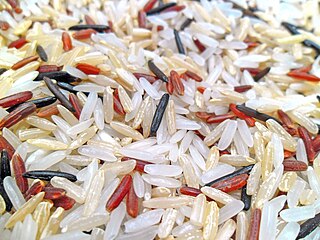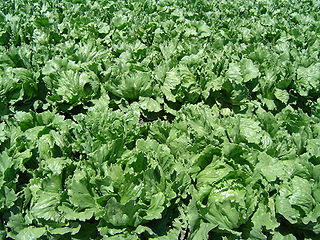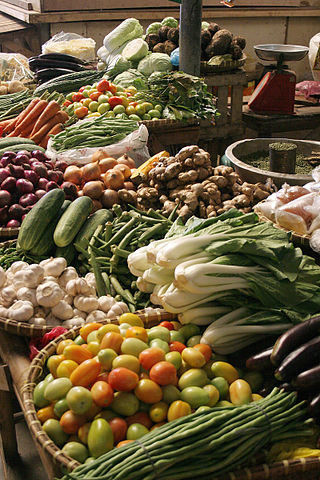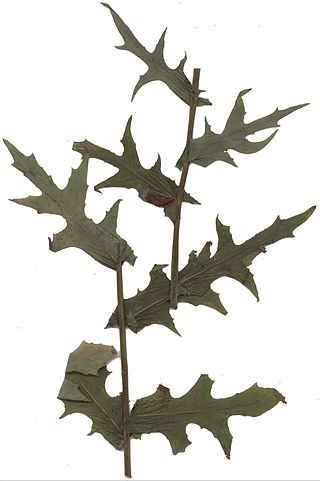
Rice is the seed of the grass species Oryza sativa or, less commonly, O. glaberrima. The name wild rice is usually used for species of the genera Zizania and Porteresia, both wild and domesticated, although the term may also be used for primitive or uncultivated varieties of Oryza.

Cabbage, comprising several cultivars of Brassica oleracea, is a leafy green, red (purple), or white biennial plant grown as an annual vegetable crop for its dense-leaved heads. It is descended from the wild cabbage, and belongs to the "cole crops" or brassicas, meaning it is closely related to broccoli and cauliflower ; Brussels sprouts ; and Savoy cabbage.

Lettuce is an annual plant of the family Asteraceae. It is most often grown as a leaf vegetable, but sometimes for its stem and seeds. Lettuce is most often used for salads, although it is also seen in other kinds of food, such as soups, sandwiches and wraps; it can also be grilled. One variety, celtuce, is grown for its stems, which are eaten either raw or cooked. In addition to its main use as a leafy green, it has also gathered religious and medicinal significance over centuries of human consumption. Europe and North America originally dominated the market for lettuce, but by the late 20th century the consumption of lettuce had spread throughout the world. As of 2021, world production of lettuce and chicory was 27 million tonnes, 53 percent of which came from China.

Broccoli is an edible green plant in the cabbage family whose large flowering head, stalk and small associated leaves are eaten as a vegetable. Broccoli is classified in the Italica cultivar group of the species Brassica oleracea. Broccoli has large flower heads, usually dark green, arranged in a tree-like structure branching out from a thick stalk which is usually light green. The mass of flower heads is surrounded by leaves. Broccoli resembles cauliflower, which is a different but closely related cultivar group of the same Brassica species.

Spinach is a leafy green flowering plant native to central and Western Asia. It is of the order Caryophyllales, family Amaranthaceae, subfamily Chenopodioideae. Its leaves are a common edible vegetable consumed either fresh, or after storage using preservation techniques by canning, freezing, or dehydration. It may be eaten cooked or raw, and the taste differs considerably; the high oxalate content may be reduced by steaming.

The parsnip is a root vegetable closely related to carrot and parsley, all belonging to the flowering plant family Apiaceae. It is a biennial plant usually grown as an annual. Its long taproot has cream-colored skin and flesh, and, left in the ground to mature, becomes sweeter in flavor after winter frosts. In its first growing season, the plant has a rosette of pinnate, mid-green leaves. If unharvested, it produces a flowering stem topped by an umbel of small yellow flowers in its second growing season, later producing pale brown, flat, winged seeds. By this time, the stem has become woody, and the tap root inedible. Precautions should be taken when handling the stems and foliage, as parsnip sap can cause a skin rash or even blindness if exposed to sunlight after handling.

The Brussels sprout is a member of the Gemmifera cultivar group of cabbages, grown for its edible buds. The leaf vegetables are typically 1.5–4.0 cm (0.6–1.6 in) in diameter and resemble miniature cabbages. The Brussels sprout has long been popular in Brussels, Belgium, from which it gained its name.
Northern root-knot nematode is a species of vegetable pathogens which produces tiny galls on around 550 crop and weed species. They invade root tissue after birth. Females are able to lay up to 1,000 eggs at a time in a large egg mass. By surviving harsh winters, they can survive in cold climates.

Basmati, pronounced['bɑːsmət̪iː], is a variety of long, slender-grained aromatic rice which is traditionally grown in the Indian subcontinent, mainly India, Pakistan, Sri Lanka and Nepal. As of 2019, India accounted for 65% of the international trade in basmati rice, while Pakistan accounted for the remaining 35%. Many countries use domestically grown basmati rice crops; however, basmati is geographically exclusive to certain districts of India and Pakistan.

Leaf vegetables, also called leafy greens, pot herbs, vegetable greens, or simply greens, are plant leaves eaten as a vegetable, sometimes accompanied by tender petioles and shoots. Leaf vegetables eaten raw in a salad can be called salad greens.

Celtuce, also called stem lettuce, celery lettuce, asparagus lettuce, or Chinese lettuce, is a cultivar of lettuce grown primarily for its thick stem or its leaves. It is used as a vegetable. In mainland China, the family is informally called woju, which is also the name of a cultivar. It is especially popular in both mainland China and Taiwan, where the stem is interchangeably called wosun or qingsun.

Lactuca virosa is a plant in the Lactuca (lettuce) genus, often ingested for its mild analgesic and sedative effects. It is related to common lettuce, and is often called wild lettuce, bitter lettuce, laitue vireuse, opium lettuce, poisonous lettuce, tall lettuce, great lettuce or rakutu-karyumu-so.

Moringa oleifera is a fast-growing, drought-resistant tree of the family Moringaceae, native to the Indian subcontinent and used extensively in South and Southeast Asia. Common names include moringa, drumstick tree, horseradish tree, or malunggay.

Lactuca serriola, also called prickly lettuce, milk thistle, compass plant, and scarole, is an annual or biennial plant in the tribe Cichorieae within the family Asteraceae. It has a slightly fetid odor and is commonly considered a weed of orchards, roadsides and field crops. It is the closest wild relative of cultivated lettuce.

Vegetables are parts of plants that are consumed by humans or other animals as food. The original meaning is still commonly used and is applied to plants collectively to refer to all edible plant matter, including the flowers, fruits, stems, leaves, roots, and seeds. An alternative definition of the term is applied somewhat arbitrarily, often by culinary and cultural tradition. It may exclude foods derived from some plants that are fruits, flowers, nuts, and cereal grains, but include savoury fruits such as tomatoes and courgettes, flowers such as broccoli, and seeds such as pulses.

Lactuca canadensis is a species of wild lettuce known by the common names Canada lettuce, Canada wild lettuce, and tall lettuce. Its true native range is not clear, but it is considered to be a native of the eastern and central parts of North America. It naturalized in the western part of the continent as well as in Eurasia.

Agriculture in Kenya dominates Kenya's economy. 15–17 percent of Kenya's total land area has sufficient fertility and rainfall to be farmed, and 7–8 percent can be classified as first-class land. In 2006, almost 75 percent of working Kenyans made their living by farming, compared with 80 percent in 1980. About one-half of Kenya's total agricultural output is non-marketed subsistence production.

A crop wild relative (CWR) is a wild plant closely related to a domesticated plant. It may be a wild ancestor of the domesticated (cultivated) plant or another closely related taxon.

Garlic production in China is significant to the worldwide garlic industry, as China provides 80% of the total world production and is the leading exporter. Following China, other significant garlic producers include India and Bangladesh (1%). As of 2019, China produced 23 million tonnes annually.

Lactuca quercina is a species of wild lettuce native to Europe and Asia. It is an annual or biennial herb in the tribe Cichorieae within the family Asteraceae growing from a taproot to maximum heights of 50–200 cm (19.5–78.5 in) or more.





















